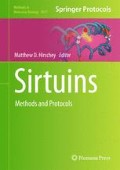Abstract
Stable Isotope Labeling by Amino acids in Cell culture (SILAC) is one of the in vivo metabolic labeling methods widely used for dynamic analysis of protein modifications. Here, we describe a general approach to applying SILAC, in combination with affinity enrichment of acetyllysine peptides and mass spectrometry, to study the dynamic changes of the Lysine acetylome in response to Sirt1. The method should be applicable to quantify changes to other post translational modifications in diverse cellular systems.
Access this chapter
Tax calculation will be finalised at checkout
Purchases are for personal use only
References
Gershey EL, Vidali G, Allfrey VG (1968) Chemical studies of histone acetylation. The occurrence of epsilon-N-acetyllysine in the f2a1 histone. J Biol Chem 243(19):5018–5022
Gu W, Roeder RG (1997) Activation of p53 sequence-specific DNA binding by acetylation of the p53 C-terminal domain. Cell 90(4):595–606. doi:S0092-8674(00)80521-8 [pii]
Roth SY, Denu JM, Allis CD (2001) Histone acetyltransferases. Annu Rev Biochem 70:81–120. doi:70/1/81 [pii] 10.1146/annurev.biochem.70.1.81
Kim SC, Sprung R, Chen Y, Xu Y, Ball H, Pei J, Cheng T, Kho Y, Xiao H, Xiao L, Grishin NV, White M, Yang XJ, Zhao Y (2006) Substrate and functional diversity of lysine acetylation revealed by a proteomics survey. Mol Cell 23(4):607–618. doi:10.1016/j.molcel.2006.06.026
Choudhary C, Kumar C, Gnad F, Nielsen ML, Rehman M, Walther TC, Olsen JV, Mann M (2009) Lysine acetylation targets protein complexes and co-regulates major cellular functions. Science 325(5942):834–840. doi:1175371 [pii] 10.1126/science.1175371
Zhang J, Sprung R, Pei J, Tan X, Kim S, Zhu H, Liu CF, Grishin NV, Zhao Y (2009) Lysine acetylation is a highly abundant and evolutionarily conserved modification in Escherichia coli. Mol Cell Proteomics 8(2):215–225. doi:M800187-MCP200 [pii] 10.1074/mcp.M800187-MCP200
Wang Q, Zhang Y, Yang C, Xiong H, Lin Y, Yao J, Li H, Xie L, Zhao W, Yao Y, Ning ZB, Zeng R, Xiong Y, Guan KL, Zhao S, Zhao GP (2010) Acetylation of metabolic enzymes coordinates carbon source utilization and metabolic flux. Science 327(5968):1004–1007. doi:327/5968/1004 [pii] 10.1126/science.1179687
Zhao S, Xu W, Jiang W, Yu W, Lin Y, Zhang T, Yao J, Zhou L, Zeng Y, Li H, Li Y, Shi J, An W, Hancock SM, He F, Qin L, Chin J, Yang P, Chen X, Lei Q, Xiong Y, Guan KL (2010) Regulation of cellular metabolism by protein lysine acetylation. Science 327(5968):1000–1004. doi:327/5968/1000 [pii] 10.1126/science.1179689
Chen Y, Zhao W, Yang JS, Cheng Z, Luo H, Lu Z, Tan M, Gu W, Zhao Y (2012) Quantitative acetylome analysis reveals the roles of SIRT1 in regulating diverse substrates and cellular pathways. Mol Cell Proteomics 11(10):1048–1062. doi:M112.019547 [pii] 10.1074/mcp.M112.019547
Luo J, Nikolaev AY, Imai S, Chen D, Su F, Shiloh A, Guarente L, Gu W (2001) Negative control of p53 by Sir2alpha promotes cell survival under stress. Cell 107(2):137–148. doi:S0092-8674(01)00524-4 [pii]
Vaziri H, Dessain SK, Ng Eaton E, Imai SI, Frye RA, Pandita TK, Guarente L, Weinberg RA (2001) hSIR2(SIRT1) functions as an NAD-dependent p53 deacetylase. Cell 107(2):149–159. doi:S0092-8674(01)00527-X [pii]
Peng L, Yuan Z, Ling H, Fukasawa K, Robertson K, Olashaw N, Koomen J, Chen J, Lane WS, Seto E (2011) SIRT1 deacetylates the DNA methyltransferase 1 (DNMT1) protein and alters its activities. Mol Cell Biol 31(23):4720–4734. doi:MCB.06147-11 [pii] 10.1128/MCB.06147-11
Yeung F, Hoberg JE, Ramsey CS, Keller MD, Jones DR, Frye RA, Mayo MW (2004) Modulation of NF-kappaB-dependent transcription and cell survival by the SIRT1 deacetylase. EMBO J 23(12):2369–2380. doi:10.1038/sj.emboj.7600244 7600244 [pii]
Brunet A, Sweeney LB, Sturgill JF, Chua KF, Greer PL, Lin Y, Tran H, Ross SE, Mostoslavsky R, Cohen HY, Hu LS, Cheng HL, Jedrychowski MP, Gygi SP, Sinclair DA, Alt FW, Greenberg ME (2004) Stress-dependent regulation of FOXO transcription factors by the SIRT1 deacetylase. Science 303(5666):2011–2015. doi:10.1126/science.1094637 1094637 [pii]
Nemoto S, Fergusson MM, Finkel T (2005) SIRT1 functionally interacts with the metabolic regulator and transcriptional coactivator PGC-1{alpha}. J Biol Chem 280(16):16456–16460. doi:M501485200 [pii] 10.1074/jbc.M501485200
Imai S, Armstrong CM, Kaeberlein M, Guarente L (2000) Transcriptional silencing and longevity protein Sir2 is an NAD-dependent histone deacetylase. Nature 403(6771):795–800. doi:10.1038/35001622
Olsen JV, de Godoy LM, Li G, Macek B, Mortensen P, Pesch R, Makarov A, Lange O, Horning S, Mann M (2005) Parts per million mass accuracy on an Orbitrap mass spectrometer via lock mass injection into a C-trap. Mol Cell Proteomics 4(12):2010–2021. doi:T500030-MCP200 [pii] 10.1074/mcp.T500030-MCP200
Perkins DN, Pappin DJ, Creasy DM, Cottrell JS (1999) Probability-based protein identification by searching sequence databases using mass spectrometry data. Electrophoresis 20(18):3551–3567. doi:10.1002/(SICI)1522-2683(19991201)20:18<3551::AID-LPS3551>3.0.CO;2–2 [pii] 10.1002/(SICI)1522-2683(19991201)20:18<3551::AID-ELPS3551>3.0.CO;2–2
Cox J, Mann M (2008) MaxQuant enables high peptide identification rates, individualized p.p.b.-range mass accuracies and proteome-wide protein quantification. Nat Biotechnol 26(12):1367–1372. doi:nbt.1511 [pii] 10.1038/nbt.1511
Cox J, Matic I, Hilger M, Nagaraj N, Selbach M, Olsen JV, Mann M (2009) A practical guide to the MaxQuant computational platform for SILAC-based quantitative proteomics. Nat Protoc 4(5):698–705. doi:nprot.2009.36 [pii] 10.1038/nprot.2009.36
Acknowledgements
Research reported in this publication was supported by the National Cancer Institute of the National Institutes of Health under Award Number CA126832 and RR020839 to Y. Zhao. The content is solely the responsibility of the authors and does not necessarily represent the official views of the National Institutes of Health. Y. Zhao is also supported by the Nancy and Leonard Florsheim Family Fund. Y. Chen is supported by NIH Fellowship (T32 HL094282).
Author information
Authors and Affiliations
Editor information
Editors and Affiliations
Rights and permissions
Copyright information
© 2013 Springer Science+Business Media, LLC
About this protocol
Cite this protocol
Chen, Y., Colak, G., Zhao, Y. (2013). SILAC-Based Quantification of Sirt1-Responsive Lysine Acetylome. In: Hirschey, M. (eds) Sirtuins. Methods in Molecular Biology, vol 1077. Humana Press, Totowa, NJ. https://doi.org/10.1007/978-1-62703-637-5_7
Download citation
DOI: https://doi.org/10.1007/978-1-62703-637-5_7
Published:
Publisher Name: Humana Press, Totowa, NJ
Print ISBN: 978-1-62703-636-8
Online ISBN: 978-1-62703-637-5
eBook Packages: Springer Protocols

